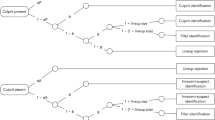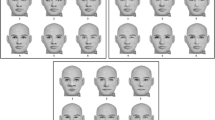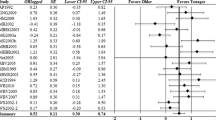Abstract
What do eyewitness identification experiments typically show? We address this question through a meta-analysis of 94 comparisons between target-present and target-absent lineups. The analyses showed that: (a) correct identifications and correct-nonidentifications were uncorrelated, (b) suspect identifications were more diagnostic with respect to the suspect’s guilt or innocence than any other response, (c) nonidentifications were diagnostic of the suspect’s innocence, (d) the diagnosticity of foil identifications depended on lineup composition, and (e) don’t know responses were nondiagnostic with respect to guilt or innocence. Results of diagnosticity analyses for simultaneous and sequential lineups varied for full-sample versus direct-comparison analyses. Diagnosticity patterns also varied as a function of lineup composition. Theoretical, forensic, and legal implications are discussed.


Similar content being viewed by others
Notes
It is clear that the numbers of simultaneous and sequential lineups do not add to the total of 94. The reason is that we separated out a set of lineups that were presented in a manner that might be described as a hybrid of simultaneous and sequential procedures (Yarmey et al., 1996). Witnesses were presented with the photographs sequentially, but at the end of the sequence were allowed to go back through the photographs again. The authors noted that the use of this hybrid procedure was motivated by Canadian law at that time. The means for the hybrid procedure were as follows: In TP lineups, suspect, foil, and nonidentifications were: .390, .390, and .220, and in TA lineups: .193, .493, and .315.
The modified Z is like the standard Z, but uses the deviations about the median (rather than the mean) as in the denominator. The advantage is that the median, as a measure of central tendency, is less influenced than the mean by the presence of the extreme score that one is trying to identify. The modified Z scores for the two scores we have identified as outliers were 3.04 (Lindsay & Wells, 1985) and 7.28 (Melara et al., 1989). The Lindsay and Wells result is lower than the 3.5 cutoff used by Iglewicz and Hoaglin (1993); however its large sample size gave it considerable weight, particularly in the Wells and Olson (2002) calculations.
Simultaneous lineups in simultaneous-sequential comparisons were on average larger (6.8) than simultaneous lineups in studies without a sequential comparison (6.1), which would tend to reduce Susp/Susp+Foil for those studies (in opposition to the obtained results) An analysis only for studies where k = 6 showed the same pattern of results, but with only three cases for the simultaneous-with-sequential condition.
Ebbesen and Konecni (1996) directed their criticism at the failure to distinguish between misses versus false alarms. Their use of the term false alarm includes identifications of foils in both TP and TA lineups, as well as identifications of innocent suspects in TA lineups. Our concern here is directed at errors in TP lineups versus TA lineups; however, the point is the same—that experts should not fail to distinguish between different categories of identification errors, as they are likely to be produced by different mechanisms, and are certainly to have different legal implications.
References
*Brewer, N., Keast, A., & Rishworth, A. (2002). The confidence-accuracy relationship in eyewitness identification: The effects of reflection and disconfirmation on correlation and calibration. Journal of Experimental Psychology: Applied, 8, 44–56.
Brown, E., Deffenbacher, K., & Sturgill, W. (1977). Memory for faces and the circumstances of encounter. Journal of Applied Psychology, 62, 311–318.
*Clare, J., & Lewandowsky, S. (2004). Verbalizing facial memory: Criterion effects in verbal overshadowing. Journal of Experimental Psychology: Learning, Memory, & Cognition, 4, 739–755.
Clark, S. E. (2003). A memory and decision model for eyewitness identification. Applied Cognitive Psychology, 17, 629–654.
Clark, S. E. (2005). A re-examination of the effects of biased lineup instructions in eyewitness identification. Law & Human Behavior, 29, 395–424.
Clark, S. E., & Gronlund, S. D. (1996). Global matching models of recognition memory: How the models fit the data. Psychonomic Bulletin and Review, 3, 37–60.
*Clark S. E., & Tunnicliff, J. L. (2001). Selecting lineup foils in eyewitness identification experiments: Experimental control and real-world simulation. Law & Human Behavior, 25, 199–216.
*Cutler, B. L., Penrod, S. D., & Martens, T. K. (1987a). Improving the reliability of eyewitness identification: Putting context into context. Journal of Applied Psychology, 72, 629–637.
*Cutler, B. L., Penrod, S. D., & Martens, T. K. (1987b). The reliability of eyewitness identification: The role of system and estimator variables. Law & Human Behavior, 11, 233–258.
Cohen, J. (1988). Statistical power analysis for the behavioral sciences (2nd ed,). Hillsdale, NJ: Erlbaum.
Daubert et al., v. Merrell Dow Pharmeceuticals, Inc., 509 U.S. 579 (1993).
Deffenbacher, K. A., Bornstein, B. H., & Penrod, S. D. (2006). Mugshot exposure effects: Retroactive interference, mugshot commitment, source confusion, and unconscious transference. Law & Human Behavior, 30, 287–307.
Deffenbacher, K. A., Bornstein, B. H., Penrod, S. D., & McGorty, E. K. (2004). A meta-analytic review of the effects of high stress on eyewitness memory. Law & Human Behavior, 6, 687–706.
*Dekle, D. J., Beal, C. R., Elliott, R., & Huneycutt, D. (1996). Children as witnesses: A comparison of lineup versus showup identification methods. Applied Cognitive Psychology, 10, 1–12.
*Devenport J. L., & Fisher R. P. (1996). The effects of authority and social influence on eyewitness suggestibility and person recognition. Journal of Police and Criminal Psychology, 11, 35–40.
*Dunning, D., & Stern, L. B. (1994). Distinguishing accurate from inaccurate eyewitness identifications via inquiries about decision processes. Journal of Personality and Social Psychology, 67, 818–835.
*Dysart, J. E., & Lindsay, R. C. L. (2001). A preidentification questioning effect: Serendipitously increasing correct rejections. Law & Human Behavior, 25, 155–165.
Ebbesen, E. B., & Konecni, V. J. (1996). Eyewitness memory research: Probative v. prejudicial value. Expert Evidence: The international Digest of Human Behaviour, Science, and the Law, 5, 2–28.
Egeth, H. E. (1993). What do we not know about eyewitness identification. American Psychologist, 48, 577–580.
Egeth, H. E. (1995). Expert psychological testimony about eyewitnesses: An update. In F. Kessel (Ed.) Psychology, science, and human affairs: Essays in honor of William Bevan (pp. 151–166). Boulder, CO: Westview Press.
Elliott, R. (1993). Expert testimony about eyewitness identification: A critique. Law & Human Behavior, 4, 423–437.
*Fleet, M. L., Brigham, J. C., & Bothwell, R. K. (1987). The confidence-accuracy relationship: The effects of confidence assessment and choosing. Journal of Applied Social Psychology, 17, 171–187.
*Geiselman, R. E., MacArthur, A., & Meerovitch, S. (1993). Transference of perpetrator roles in eyewitness identifications from photoarrays. American Journal of Forensic Psychology, 11, 5–15.
Green, D. M., & Swets, J. A. (1966). Signal detection theory and psychophysics. Oxford, England: Wiley.
Glanzer, M., & Adams, J. K. (1985). The mirror effect in recognition memory. Memory & Cognition, 11, 8–20.
Glanzer, M., & Adams, J. K. (1990). The mirror effect in recognition memory: Data and theory. Journal of Experimental Psychology: Learning, Memory, & Cognition, 1, 5–16
*Gonzalez, R., Ellsworth, P. C., & Pembroke, M. (1993). Response biases in lineups and show ups. Journal of Personality & Social Psychology, 4, 525–537.
Gronlund, S. D. (2005). Sequential lineup advantage: Contributions of distinctiveness and recollection. Applied Cognitive Psychology, 19, 23–37.
Hintzman, D. L. (1980). Simpsons Paradox and the analysis of memory retrieval. Psychological Review, 87, 398–410.
Iglewicz, B., & Hoaglin, D. C. (1993). How to detect and handle outliers. Milwaukee, WI: ASQC Quality Press.
*Juslin, P., Olsson, N., & Winman, A. (1996). Calibration and diagnosticity of confidence in eyewitness identification: Comments on what can be inferred from the low confidence-accuracy correlation. Journal of Experimental Psychology: Learning, Memory, & Cognition, 22, 1304–1316.
*Kassin, S. M., Rigby, S., & Castillo, S. R. (1991). The accuracy-confidence correlation in eyewitness testimony: Limits and extensions of the retrospective self-awareness effect. Journal of Personality & Social Psychology, 61, 689–707.
*Kneller, W., Memon, A., & Stevenage, S. (2001). Simultaneous and sequential lineups: Decision processes of accurate and inaccurate eyewitnesses. Applied Cognitive Psychology, 15, 659–671.
*Krafka, C., & Penrod, S. (1985). Reinstatement of context in a field experiment on eyewitness identification. Journal of Personality & Social Psychology, 49, 58–69.
*Lindsay, R. C. (1986). Confidence and accuracy of eyewitness identification from lineups. Law & Human Behavior, 10, 229–239.
*Lindsay, R. C. L., Lea, J. A., & Fulford, J. A. (1991). Sequential lineup presentation: Technique matters. Journal of Applied Psychology, 76, 741–745.
*Lindsay R. C. L., Lea J. A., Nosworthy G. J., Fulford J. A., Hector J., LeVan V., & Seabrook C. (1991). Biased lineups: Sequential presentation reduces the problem. Journal of Applied Psychology, 76, 796–802.
Lindsay, R. C. L., Martin, R., & Webber, L. (1994). Default values in eyewitness descriptions: a problem for the match-to-description lineup foil selection strategy. Law & Human Behavior, 18, 527–541.
*Lindsay, R. C., Wallbridge, H., & Drennan, D. (1987). Do the clothes make the man? An exploration of the effect of lineup attire on eyewitness identification accuracy. Canadian Journal of Behavioural Science. Special Forensic Psychology, 19, 463–478.
*Lindsay, R. C., & Wells, G. L. (1980). What price justice? Exploring the relationship of lineup fairness to identification accuracy. Law & Human Behavior, 4, 303–313.
*Lindsay, R. C. L., & Wells, G. L. (1985). Improving eyewitness identifications from lineups: Simultaneous versus sequential lineup presentation. Journal of Applied Psychology, 70, 556–564.
Malpass, R. S., & Devine, P. G. (1981a). Guided memory in eyewitness identification. Journal of Applied Psychology, 3, 343–350.
*Malpass, R. S., & Devine, P. G. (1981b). Eyewitness identification: Lineup instructions and the absence of the offender. Journal of Applied Psychology, 4, 482–489.
McCloskey, M., & Egeth, H. (1983). Eyewitness identification: What can a psychologist tell a jury? American Psychologist, 38, 550–563.
Meissner, C. A., Tredoux, C. G., Parker, J. F., & MacLin, O. H. (2005). Eyewitness decisions in simultaneous and sequential lineups: A dual-process signal detection theory analysis. Memory & Cognition, 33, 783–792.
*Melara, R. D., DeWitt-Rickards, T. S., & O’Brien, T. P. (1989). Enhancing lineup identification accuracy: Two codes are better than one. Journal of Applied Psychology, 74, 706–713.
Memon, A., Hope, L., & Bull, R. (2003). Exposure duration: Effects on eyewitness accuracy and confidence. British Journal of Psychology, 3, 339–354.
*Murray, D. M., & Wells, G. L. (1982). Does knowledge that a crime was staged affect eyewitness performance? Journal of Applied Social Psychology, 12, 42–53.
Navon, D. (1992). Selection of lineup foils by similarity to suspect is likely to misfire. Law and Human Behavior, 16, 575–593.
*Paley, B., & Geiselman, R. E. (1989). The effects of alternative photospread instructions on suspect identification performance. American Journal of Forensic Psychology, 7, 3–13.
*Parker, J. F., & Carranza, L. E. (1989). Eyewitness testimony of children in target-present and target-absent lineups. Law & Human Behavior, 13, 133–149.
*Parker, J. F., & Ryan, V. (1993). An attempt to reduce guessing behavior in children's and adults’ eyewitness identifications. Law & Human Behavior. Special Law, Psychology, and Children, 17, 11–26.
People v. Smith (2004). 2 Misc.3d 1007(A), N.Y. Slip Op. 50172(U).
*Pozzulo, J. D., & Lindsay, R. C. L. (1999). Elimination lineups: An improved identification procedure for child eyewitnesses. Law & Human Behavior, 84, 167–176.
Py, J., Demarchi, S., Ginet, M., & Wasiak, L. (2003). Who is the suspect? A complementary instruction to the standard mock witness paradigm. Presented at Psychology and Law: International, Interdisciplinary Conference, Edinburgh, Scotland.
Read, J. D. (1995). The availability heuristic in person identification: The sometimes misleading consequences of enhanced contextual information. Applied Cognitive Psychology, 2, 91–121.
*Read J. P., Tollestrup P., Hammersley R., McFadzen E., & Christensen A. (1990). The unconscious transference effect: Are innocent bystanders ever misidentified? Applied Cognitive Psychology, 4, 3–31.
Rosenthal, R. (1991). Meta-analytic procedures for social research. Newbury Park: Sage Publications.
*Sanders, G. S., & Simmons, W. L. (1983). Use of hypnosis to enhance eyewitness accuracy: Does it work? Journal of Applied Psychology, 68, 70–77.
*Searcy, J. H., Bartlett, J. C., & Memon, A. (1999). Age differences in accuracy and choosing in eyewitness identification and face recognition. Memory & Cognition, 27, 538–552.
Semmler, C., Brewer, N., & Wells, G. L. (2004). Effects of postidentification feedback on eyewitness identification and nonidentification confidence. Journal of Applied Psychology, 89, 334–346.
Simpson, E. H. (1951). The interpretation of interaction in contingency tables. Journal of the Royal Statistical Society, B, 13, 238–241.
*Sporer, S. L. (1993). Eyewitness identification accuracy, confidence, and decision times in simultaneous and sequential lineups. Journal of Applied Psychology, 78, 22–33.
*Sporer, S. L. (1992). Post-dicting eyewitness accuracy: Confidence, decision-times and person descriptions of choosers and non-choosers. European Journal of Social Psychology, 74, 157–180.
Steblay, N. M. (1992). A meta-analytic review of the weapon focus effect. Law & Human Behavior, 4, 413–424.
Steblay, N., Dysart, J., Fulero, S., & Lindsay, R. C. L. (2001). Eyewitness accuracy rates in sequential and simultaneous lineup presentations: A meta-analytic comparison. Law & Human Behavior, 5, 459–473.
Steblay, N., Dysart, J., Fulero, S., & Lindsay, R. C. L. (2003). Eyewitness accuracy rates in police showup and lineup presentations: A meta-analytic comparison. Law & Human Behavior, 5, 523–540.
Stouffer, S. A., Suchman, E. A., DeVinney, L. C., Starr, S. A., & Williams, R. M., Jr. (1949). The American soldier: Adjustment during army life (vol. I). Princeton, NJ. Princeton University Press.
Swets, J. A. (1996). Signal detection theory and RO analysis in psychology and diagnosis. Mahwah, NJ: Erlbaum.
*Tunnicliff, J. L., & Clark, S. E. (2000). Selecting foils for identification lineups: Matching suspects or descriptions? Law & Human Behavior, 24, 231–258.
U.S. Congress. (2004). Federal Rules of Evidence. Committee on the Judiciary, 108th Congress, House of Representatives. Washington, DC: U.S. Government Printing Office.
*Wells, G. L. (1984). The psychology of lineup identifications. Journal of Applied Social Psychology, 14, 89–103.
Wells, G. L. (1993). What do we know about eyewitness identification? American Psychologist, 48, 553–571.
*Wells, G. L., Charman, S. D., & Olson, E. A. (2005). Building face composites can harm lineup identification performance. Journal of Experimental Psychology: Applied, 11, 147–156.
*Wells, G. L., Ferguson, T. J., & Lindsay, R. C. (1981). The tractability of eyewitness confidence and its implications for triers of fact. Journal of Applied Psychology, 66, 688–696.
Wells, G. L., & Lindsay, R. C. (1980). On estimating the diagnosticity of eyewitness nonidentifications. Psychological Bulletin, 3, 776–784.
Wells, G. L., & Olson, E. A. (2002). Eyewitness identification: Information gain from incriminating and exonerating behaviors. Journal of Experimental Psychology: Applied, 3, 155–167.
*Wells, G. L., Rydell, S. M., & Seelau, E. P. (1993). The selection of distractors for eyewitness lineups. Journal of Applied Psychology, 78, 835–844.
Wells, G. L., Small, M., Penrod, S., Malpass, R. S., Fulero, S. M., & Brimacombe, C. A. E. (1998). Eyewitness identification procedures: Recommendations for lineups and photospreads. Law & Human Behavior, 22, 603–647.
Wells, G. L., & Turtle, J. W. (1986). Eyewitness identification: The importance of lineup models. Psychological Bulletin, 99, 320–329.
Wogalter, M. S., Marwitz, D. B., & Leonard, D. C. (1992). Suggestiveness in photo spread line-ups: Similarity induces distinctiveness. Applied Cognitive Psychology, 5, 443–453
Wogalter, M. S., Malpass, R. S., & Burger, M. A. (1993). How police officers construct lineups: A national survey. Proceedings of the Human Factors and Ergonomics Society 37th Annual Meeting, pp. 640–644.
Wogalter, M. S., Malpass, R. S., & McQuiston, D. E. (2004). A national survey of U.S. police on preparation and conduct of identification lineups. Psychology, Public Policy, & Law, 10, 69–82.
*Wright, D. B., & Stroud, J. N. (2002). Age differences in lineup identification accuracy: People are better with their own age. Law & Human Behavior, 66, 641–654.
*Yarmey, A. D., Yarmey, M. J., & Yarmey, A. L. (1996). Accuracy of eyewitness identification in showups and lineups. Law & Human Behavior, 4, 459–477.
*Yarmey, A. D., Yarmey, A. L., & Yarmey, M. J. (1994). Face and voice identifications in showups and lineups. Applied Cognitive Psychology, 8, 453–464.
Yule, G. U. (1903). Notes on the theory of association of attributes in statistics. Biometrika, 2, 121–134.
Acknowledgements
This research was supported by National Science Foundation grant SES 0214373 awarded to Steven Clark. We wish to thank Brynn Nodarse for her assistance, and to all the reviewers for their very helpful comments and suggestions which improved the paper substantially.
Author information
Authors and Affiliations
Corresponding author
Additional information
*Included in the meta-analysis.
Appendix
Appendix
Results from all 94 studies, suspect, foil, and nonidentification responses, for target-present and target-absent lineups are shown in Table A.1. An explanation of the various abbreviations is given in Table A.2.
About this article
Cite this article
Clark, S.E., Howell, R.T. & Davey, S.L. Regularities in Eyewitness Identification. Law Hum Behav 32, 187–218 (2008). https://doi.org/10.1007/s10979-006-9082-4
Received:
Accepted:
Published:
Issue Date:
DOI: https://doi.org/10.1007/s10979-006-9082-4




